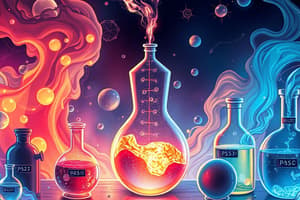Podcast
Questions and Answers
If a gas has a volume of 500 mL at 20°C, what would its volume be at 40°C, assuming constant pressure and amount of gas?
If a gas has a volume of 500 mL at 20°C, what would its volume be at 40°C, assuming constant pressure and amount of gas?
- 250 mL
- 667 mL (correct)
- 500 mL
- 400 mL
What is Charles's Law primarily used to describe?
What is Charles's Law primarily used to describe?
- The relationship between pressure and volume of a gas at constant temperature
- The relationship between pressure and temperature of a gas
- The relationship between volume and temperature of a gas at constant pressure (correct)
- The behavior of an ideal gas under different conditions
What is the primary difference between Charles's Law and Gay-Lussac's Law?
What is the primary difference between Charles's Law and Gay-Lussac's Law?
- Charles's Law deals with volume, while Gay-Lussac's Law deals with pressure (correct)
- Charles's Law deals with pressure, while Gay-Lussac's Law deals with volume
- Charles's Law is used for real gases, while Gay-Lussac's Law is used for ideal gases
- Charles's Law is used for ideal gases, while Gay-Lussac's Law is used for real gases
What is the pressure of the tire in Ahmed's Land Cruiser when the temperature is 25°C, given that it is 35 psi at 45°C?
What is the pressure of the tire in Ahmed's Land Cruiser when the temperature is 25°C, given that it is 35 psi at 45°C?
What is the constant in the equation PV = nRT, where P is the pressure, V is the volume, n is the number of moles, R is the gas constant, and T is the temperature in Kelvin?
What is the constant in the equation PV = nRT, where P is the pressure, V is the volume, n is the number of moles, R is the gas constant, and T is the temperature in Kelvin?
Which of the following statements is true about ideal gases?
Which of the following statements is true about ideal gases?
If 4.8 g of methane gas (CH4) is placed in a 2 L container at 25 °C, what is the pressure in atm?
If 4.8 g of methane gas (CH4) is placed in a 2 L container at 25 °C, what is the pressure in atm?
What is the volume of 3.2 moles of gas at SATP conditions?
What is the volume of 3.2 moles of gas at SATP conditions?
What is the molar volume of a gas at STP?
What is the molar volume of a gas at STP?
If 2.4 moles of gas occupies 50 L at 1.5 atm pressure, what will be the temperature in °C?
If 2.4 moles of gas occupies 50 L at 1.5 atm pressure, what will be the temperature in °C?
Which gas law states that the volume of a gas is directly proportional to its absolute temperature at constant pressure?
Which gas law states that the volume of a gas is directly proportional to its absolute temperature at constant pressure?
If 3 moles of nitrogen gas (N2) are at 5 atm pressure, what will be the volume occupied at 27 °C?
If 3 moles of nitrogen gas (N2) are at 5 atm pressure, what will be the volume occupied at 27 °C?
What property of gases allows them to take up the largest possible volume?
What property of gases allows them to take up the largest possible volume?
Which statement best describes the behavior of gas particles according to the kinetic theory of gases?
Which statement best describes the behavior of gas particles according to the kinetic theory of gases?
Which gas law describes the inverse relationship between pressure and volume of a gas?
Which gas law describes the inverse relationship between pressure and volume of a gas?
What happens to the total kinetic energy of gas particles during elastic collisions?
What happens to the total kinetic energy of gas particles during elastic collisions?
Which property helps distinguish gases from solids and liquids?
Which property helps distinguish gases from solids and liquids?
Which gas law combines the relationships between pressure, volume, and temperature?
Which gas law combines the relationships between pressure, volume, and temperature?
Flashcards are hidden until you start studying




